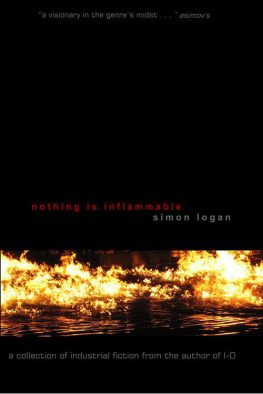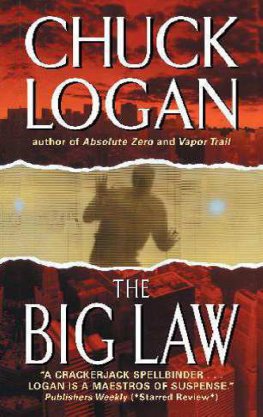Simon Logan - Nothing is Inflammable
Here you can read online Simon Logan - Nothing is Inflammable full text of the book (entire story) in english for free. Download pdf and epub, get meaning, cover and reviews about this ebook. year: 2006, publisher: Prime, genre: Detective and thriller. Description of the work, (preface) as well as reviews are available. Best literature library LitArk.com created for fans of good reading and offers a wide selection of genres:
Romance novel
Science fiction
Adventure
Detective
Science
History
Home and family
Prose
Art
Politics
Computer
Non-fiction
Religion
Business
Children
Humor
Choose a favorite category and find really read worthwhile books. Enjoy immersion in the world of imagination, feel the emotions of the characters or learn something new for yourself, make an fascinating discovery.
- Book:Nothing is Inflammable
- Author:
- Publisher:Prime
- Genre:
- Year:2006
- Rating:3 / 5
- Favourites:Add to favourites
- Your mark:
- 60
- 1
- 2
- 3
- 4
- 5
Nothing is Inflammable: summary, description and annotation
We offer to read an annotation, description, summary or preface (depends on what the author of the book "Nothing is Inflammable" wrote himself). If you haven't found the necessary information about the book — write in the comments, we will try to find it.
Nothing is Inflammable — read online for free the complete book (whole text) full work
Below is the text of the book, divided by pages. System saving the place of the last page read, allows you to conveniently read the book "Nothing is Inflammable" online for free, without having to search again every time where you left off. Put a bookmark, and you can go to the page where you finished reading at any time.
Font size:
Interval:
Bookmark:

NOTHING IS INFLAMMABLE
BY SIMON LOGAN
NOTHING IS INFLAMMABLE
A collection of industrial short stories
Copyright 2011 by Simon Logan
Originally published by Prime Books 2006.
Cover art & design copyright 2006 by Simon Logan
No portion of this book may be reproduced by any means, mechanical, electronic, or otherwise, without first obtaining the permission of the copyright holder.
For more information:
http://www.coldandalone.com
Contents
a lone mecha-scientist / paranoia and phobias
ghosts in the static / skeletal high-rises
guerilla documentaries / underground beauty contests
activists and cyborgs / deviant sex
two broken souls / destruction and love
a renegade filmmaker / dirty aggression
a tattooed punk / hidden machines attack
a viral Romeo and Juliet / poisons and hatred
Chapter One
Wherein the lone mecha-scientist, Dziga, introduces himself and his work.
My name is Dziga and this is my work. This is my life.
Since January I have resided in this lab, my cage. There are five rooms in the facility, all of which are mine to do with as I wish. The lighting is intermittent and pus-yellow, the walls and ceilings crumbling and full of exposed wires and pipes. I have all the equipment I could desire and each piece is broken or damaged. I have every chemical I need.
This is how I work.
I spent the first few weeks I was here exploring every inch of the place.
There are porcelain tiles on the floors and walls of some of the rooms, cracked and filthy with a greasy residue. There are two immense, rusted autoclaves in one room a little further along the corridor that occasionally work well enough to sterilize my equipment. There are several storage cupboards, the shelves within haphazardly filled with beakers, pipettes, Bunsen burners, racks, storage jars, large bottles, tiny micro-liter tubes and rows and rows of chemicals.
Damp stains the corners of the ceilings in most rooms and particularly in the corridors that join the complex together. There are cracks here and there from which insects and small rodents crawl out. And there is a persistent smell of chlorine in the air.
Everything has a sepia tint.
The main room from which I work apparently used to be three separate rooms that were knocked into one before I arrived. The uneven edges of the dividing walls that were hammered away are still visible; they give the impression that the building is trying to regenerate itself, like an insistent weed.
This room, which I use as my primary research chamber, is therefore about thirty feet long by fifteen feet wide, cluttered with my tools and implements as well as the litter of small experiments that I am indulging in. There are windows along one wall but, like all the others in the lab, they are clouded by years of chemical silt that has worked its way into the glass very pores.
I have no wish to look outside anyway.
I work in an appalling silence. I am alone here, except for Judas of course and, if you count it as an entity, the Protohuman. Occasionally Jakobsen or Dmitri visit but apart from that I am left to my own devices.
There is more to my life and my lab than this, of course, but this description will suffice for now. More important than the building is my work. And this is how it started.
In the last century William Levitt and his company began building what would become the community of Levittown on Long Island in America. Over the next four years a total of 17,447 homes were built, effectively creating a town through the will of a single man. 75,000 people ended up living there75,000 that had no choice but to recognize William Levitt as somewhat of a god, for without him their little society would never have existed.
He managed this feat by being one of the first to realize the awe-inspiring power of rationalization if it were used in this way. His company built each home to exact specifications, using exactly the same materials in exactly the same quantity in exactly the same way in every single house they built there. There was no need for anyone to think about how a wall should be put up or wherethis had already been decided. Each wall was put up in exactly the same way.
This homogenization is the only way such a accomplishment could have been achieved, for if Levitt had decided on how to build each house individually he would probably still be building them today. Only by deciding on the best way to do something and eliminating all other choices could it be done.
The trend was reflected elsewhere, carried by TV screens and telephone cables and modems. Everything could be scientifically managed and controlled to ensure the utmost efficiency.
Burger sizes, coffee flavors, movie plots, musical melodies, health care, marriage, even creativity.
It was all subject to the four-pronged mechanization processefficiency, calculability, predictability and control.
Except something passed through, something vital.
As I had read about Levitt and others like him while in the asylum it seemed to me that they had all missed what could be the real purpose, the real power, of scientific management.
It was then that I had formulated the theory of the Protohuman.
And this is the Protohuman.
It is chained to the wall merely to keep it upright. It watches me whenever I watch it. It occasionally wears a lab coat like mine to preserve its decency and because it bears enough resemblance to a real human being to require it.
Once, it was human just as I am. But with each day and each stage of my research it grows further and further apart from our species and into the realm of something new.
I leaned towards the Protohuman and it copied the gesture. I could see the reflection of myself in its eyes, repeated on to infinity. The scars of the past stages of the experiment were bright white on its skin, healing perfectly.
There was a commotion from the far side of the room, screeching and the sound of metal being hammered against metal. I turned from the Protohuman, sensed it sink back onto the wall as I left it and went to Judass cage.
The cage hung from the ceiling, suspended by a thick, rusted chain with a hook on the end that looped through a catch on the top. I have placed a broken steel girder under the cage to steady it and stop it swinging too much when Judas bounced around inside.
Jealous? I asked the creature.
It slammed against the metal bars at my proximity, teeth baredbut its been almost a week since Ive fed it and soon it slumps to the cages floor, exhausted. It had lost even more hair since the last time I looked closely at it. Its scrawny body seemed to be curling up day by day like a piece of fruit left in the sun, the skin visible between the uneven clumps of fur left wrinkled and covered in sores.
It barely resembled a proboscis anymore.
I poked a finger through the bars and stroked its balding head, soothing the poor creature.
You hungry, Judas? Mmm? Hungry?
I turned to the chest freezer fitted into the corner of the room. Steam poured out and there was a pneumatic hiss as the lid lifted. Chunks of raw meatshoulders, legs, great slices of torsolay within next to racks of test tubes and packs of frozen vegetables. I removed a loose nugget of fatty red meat turned pink by the sub-zero temperatures, took it to the microwave oven on a bench opposite.
The device was as old as everything else, the LCD display cracked and empty. Most of the buttons were missing, exposing the black pads that lay beneath. I had scribbled numbers in chalk on the pads but they were practically rubbed away to invisibility so I punched in numbers at random. A strip of electrical tape was all that held the door shutI removed it, placed the meat inside, then taped it shut again. I hit the wide START button and watched the meat become illuminated by a yellow glow.
Next pageFont size:
Interval:
Bookmark:
Similar books «Nothing is Inflammable»
Look at similar books to Nothing is Inflammable. We have selected literature similar in name and meaning in the hope of providing readers with more options to find new, interesting, not yet read works.
Discussion, reviews of the book Nothing is Inflammable and just readers' own opinions. Leave your comments, write what you think about the work, its meaning or the main characters. Specify what exactly you liked and what you didn't like, and why you think so.













